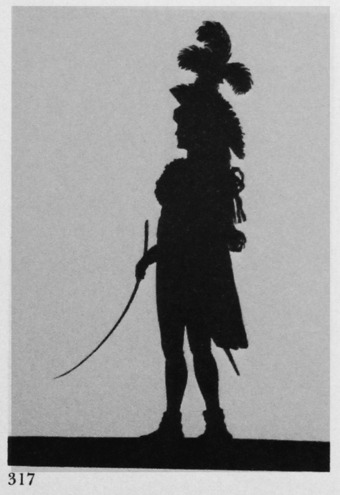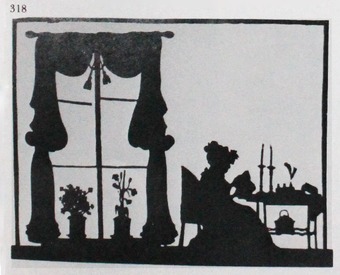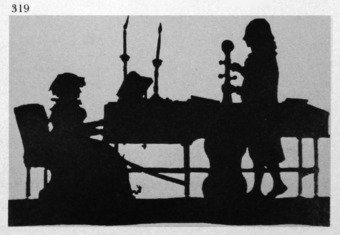Brown, Millicent, Mrs (McKechnie Section 1)
Recorded by Jackson (The History of Silhouettes). Much of Mrs Brown's work is illustrated in Rudolph L. Mégroz, Profile Art through the Ages. Mrs Jackson refers to her as 'Miss Brown', an error which she corrected in her Dictionary. I should add, however, that Foskett mentions that a 'Miss Brown' exhibited a miniature at the Society of Artists in 1783. Since Brown is such a common name. this reference may of course be coincidental.
Jackson describes (Dictionary) a volume of Mrs Brown's cut profiles, which was owned by a Mr John J. Cullen. of New Jersey. The cover of this book bore the inscription, 'Silhouettes by Mrs Brown, of Portman Square, London'. A Mrs Brown, of 15 Portman Square. is indeed mentioned in several editions of Holden's London Directory. For some reason, the editions of the years 1802-1804 give 'Miss Brown', whereas the editions of 1805-1807 give 'Mrs Brown'. The rate books of St Marylebone parish church first record a Mrs Brown at Portman Square at Michaelmas 1796. After 1800, the entries add the Christian name of Millicent, spelt sometimes as 'Millisent or 'Millicont'. From 1809, there are no further references to a Mrs Brown at this address. That the artist was indeed a married lady is evident from the parish register of St Marylebone parish church (Harleian Transcripts), which gives the following entry of marriage: '23 March, 1772: Mark Brown, Esq., to Millicent Mathews, spinster.' No wills of either Mark or Millicent Brown have yet come to light, nor are their names to be found in the records of burials at St Marylebone parish church.
Mr Cullen's album contained about three hundred cut profiles by Mrs Brown. These included more than one self-portrait, taken apparently in middle age, which was illustrated in the Antiquarian (October 1931); another is illustrated by Mégroz. One of the examples is a profile of Georgiana, first wife of the Fifth Duke of Devonshire. Some examples appear to have been cut as late as 1805. Not all the profiles are named. More than one full-length portrait of the actress Mrs Jordan, the morganatic wife of the Duke of Clarence (later William IV), was included.
317
Other sitters were Mr and Mrs Danby (a double portrait, showing Mrs Danby at the piano and her husband apparently tuning his cello),
319
Lord Cholmondeley, Lady Buckingham, Mrs Mundy (the wife of a friend of Admiral Collingwood), Lord Harrington and Mrs Fox. William Pitt, Edward Gibbon, Mrs Montague (a well known 'blue-stocking') and Voltaire (cut in white paper) were other well known subjects of Mrs Brown.
It seems most likely that Mrs Brown was a talented amateur. The volume of cuttings which I have described may well constitute her entire output. In The History of Silhouettes Jackson states that the full-length portrait of Mrs Jordan was owned at that time by Lady Dorothy Nevill. It is possible that at some period Lady Dorothy owned the entire volume of cut profiles.
Both bust-length and full-length portraits were included in the book of Mrs Brown's profiles. All were cut from white paper, which in most cases was then blackened. The illustrated examples are of full- length work, each profile apparently having been cut from one piece of paper, the base of which was retained in its rectangular form, no doubt to give stability to the finished silhouette. The portrait of Mrs Jordan shows clever slash cutting; evidently in stage costume, she carries an elegantly cut sabre, and her plumed head-dress and the ribbons on her dress are also well shown.
In the group silhouettes the furniture is well depicted, particular skill being shown in the cutting of the flickering flames of the candles. The rectangular black base seems to be a recurrent feature of Mrs Brown's work; she sometimes added sides and a top in solid black, in order to frame the picture completely.
The album also contained genre pictures, which probably also had similar black bases. Mrs Brown is said to have cut her profiles from memory. There seems no question that she used any kind of machine for her work; she appears to have been a gifted freehand cutter.
There is no evidence that Mrs Brown ever signed her work, and the discovery of her Christian name was only made recently (by Mr Percy Higgs). She may, however, have cut duplicates of her work, which she then signed and gave to friends. Signed examples of her work, therefore, might come to light.
Ills. 317-319

Mrs Jordan
Cut silhouette
? 1790s
Mr Jordan was the morganatic wife of William IV, who left her when the crisis concerning the future of the British throne came to a head at the death in childbirth of Princess Charlotte in 1816.
Mrs Jordan bore the king a number of children.
From E. Nevill Jackson, ‘The History of Silhouettes’ (1911), by courtesy of the ‘Connoisseur’

A woman reading by candlelight
Cut silhouette
1800- c. 1805
This domestic scene shows a woman reading by candlelight. Before her is an inkstand; the basket beneath the table may be her work-box, and the draped window (skilfully rendered) is adorned with plants in pots.
From Rudolph L. Mégroz, ‘Profile Art though the Age’ (1948), by courtesy of Mrs A. Mégroz Lord and Art Press

